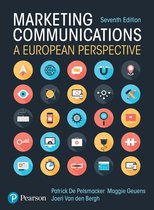Summary
Summary book Marketing Communications 2023
- Course
- Institution
- Book
A summary of the book "Marketing Communications: A European perspective" of de Pelsmacker. For the course Marketing Communications at Tilburg University. Chapter 3: How marketing communications work Chapter 4: Marketing communications planning Chapter 6/7: Media planning Chapter 12/13: Measur...
[Show more]




